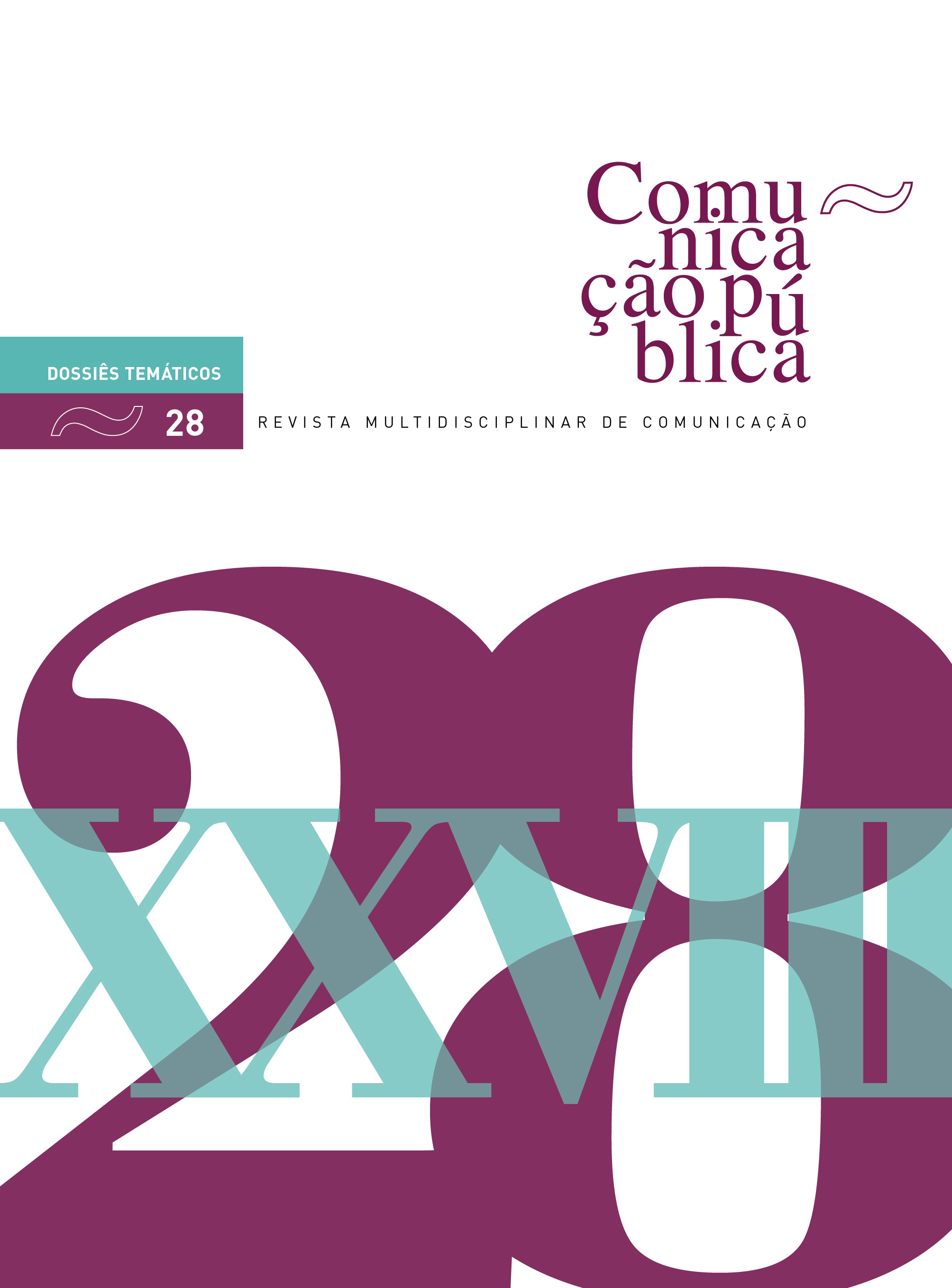New content management models
use of digital technologies by Mídia NINJA
DOI:
https://doi.org/10.4000/cp.7626Keywords:
news technologies, alternative media, content management, distributionAbstract
This article reflects on the use of new network technologies by the independent communication and activist Mídia NINJA (Independent Narratives, Journalism and Action) as an alternative model of content management that uses the tripod: production, circulation and distribution. The research aims to understand how this model works and how it attracts the public. For that, the method used is netnography (a branch of Ethnography that analyzes the behavior of individuals and social groups on the internet and the dynamics of these groups in the online environment), to observe the dynamics of two groups of the Telegram of the Mídia NINJA (NINJASP and NINJADF) and the Instagram page of this alternative medium. We complemented the methodology with a semi-structured interview. It was found, through the analysis of the contents of the studied tools, that the new technologies of digital media as a production and distribution model used by the Mídia NINJA provokes in the public an interest in reading the contents of this medium, in addition to promoting participation and interaction.
Downloads
References
Aalberg, T., Blekesaune, A., & Elvestad, E. (2013). Media choice and informed democracy: Toward increasing news consumption gaps in Europe? The International Journal of Press/Politics, 18(3), 281-303. https://doi.org/10.1177/1940161213485990
Atton, C. (2002). Alternative media. London: Sage Publications.
Barabási, A.L. (2002). Linked: The new science of networks. New York: Perseus Publishing.
Bartlett, J. (2018). The People vs Tech: How the internet is killing democracy (and how we save it). New York: Random House.
Bentes, I. (2015). Mídia-multidão: Estéticas da comunicação e biopolíticas. Rio de Janeiro: Mauad X.
Castells, M. (2007). Communication, power and counter-power in the network society. International Journal of Communication, 1, 238–266. Disponível em: http://ijoc.org/ojs/index.php/ijoc/article/view/46/35 (Acedido 10 setembro 2019).
Castells, M. (2009). Communication power. Oxford: Oxford University Press.
Coyer, K., Dowmunt, T., & Fountain, A. (2007). The alternative media handbook. Abingdon: Routledge.
Di Gennaro, C., & Dutton, W. (2006). The internet and the public: Online and offline political participation in the United Kingdom. Parliamentary Affairs, 59(2), 299–313. https://doi.org/10.1093/pa/gsl004
Downing, J. (1984) Radical media: The political experience of alternative communication. Boston: South End Press.
Downing, J. (2002). Mídia radical: Rebeldia das comunicações e movimentos sociais. São Paulo: Editora Senac.
Dryzeck, J. S. (2000). Deliberative democracy and beyond: Liberals, critics, contestations. Oxford: Oxford University Press.
Esteves, J. P. (2011). Novos media e deliberação: Sobre redes, tecnologia, informação e comunicação. Media & Jornalismo, 18(10), 31–45.
Franklin, M. I. (2012). Understanding research: Coping with the quantitative qualitative divide. New York: Routledge.
Fuchs, C. (2010). Alternative media as critical media. European Journal of Social Theory, 13(2), 173-192. https://doi.org/10.1177/1368431010362294
Fuchs, C., & Sandoval, M. (2015). The political economy of capitalist and alternative media. In C. Atton, The Routledge companion to alternative and community media (pp. 165-175). Abingdon: Routledge.
Fuchs, C. (2017). Social media. London: Sage Publications.
Hine, C. (2000). Virtual ethnography. London: Sage Publications.
Hine, C. (2005). Virtual methods. Oxford: Berg.
Humphreys, L. (2013). Mobile social media: Future challenges and opportunities. Mobile Media & Communication, 1(1), 20–25. https://doi.org/10.1177/2050157912459499
Hunsinger, J., & Senft, T. (2014). The social media handbook. New York: Routledge.
Jakubowicz, K. (2015). New media ecology: Reconceptualizing media pluralism. In P. Valcke, M. Sükösd & R. G. Picard (Eds.), Media pluralism and diversity: Concepts, risks and global trends (pp. 23-53). London: Palgrave Macmillan.
Kozinets, R. V. (1998). On netnography: Initial reflections on consumer research investigations of cyberculture. In J. W. Alba & J. W. Hutchinson (Eds.), Advances in consumer research (Vol. 25, pp. 366-371). Provo: Association for Consumer Research.
Kozinets, R. V. (2010). Netnography: Doing ethnographic research online. London: Sage Publications.
Lievrouw, L. A. (2011). Alternative and activist new media. Cambridge: Polity Press.
McQuail, D. (2019). Equality: An ambiguous value. In J. Trappel (Ed.), Digital media inequalities: Policies against divides, distrust and discrimination (pp. 31-41). Göteborg: Nordicom.
Peschanski, J. A. (2007). Communication of the oppressed: Alternative media and their political impact in contemporary Latin America. In K. Coyer, T. Dowmunt & A. Fountain (Eds.). The alternative media handbook (pp. 154-162). Abingdon: Routledge.
Rifiotis, T. (2016). Etnografia no ciberespaço como “repovoamento” e explicação. In J. Segata, & T. Rifiotis (Eds.), Políticas etnográficas no campo da cibercultura (pp. 129-151). Brasília: ABA.
Rocha, P. (2006). Jornalismo em tempos de cibercultura: um estudo do ClicRBS (Tese de Doutoramento não publicada). Pontifícia Universidade Católica do Rio Grande do Sul - PUCRS, Porto Alegre, Brasil.
Rubin, H., & Rubin, I. (2005). Qualitative interviewing: The art of hearing data. Thousand Oaks: Sage Publications.
Sandage, T. (2013). Writing on the wall: Social media - The first 2,000 Years. London: Bloomsbury.
Segata, J., & Rifiotis, T. (2016). Políticas etnográficas no campo da cibercultura. Brasília: ABA.
Seoane, M. V., & Hornidge, A. K. (2018). The social shaping of media technologies’ multiple uses: The case of Mídia NINJA in Brazil. Information, Communication and Society, 23(2), 288-303. https://doi.org/10.1080/1369118X.2018.1500623
Schuman, P. G. (1982). Libraries and alternatives. In D. James & S. Elliott (Eds.). Alternative materials in libraries (pp. 1-5). Metuchen: Scarecrow Press.
Sunstein, C. R. (2009). Republic.com 2.0. Princeton: Princeton University Press.
Trappel, J. (2019). Digital media inequalities: Policies against divides, distrust and discrimination. Göteborg: Nordicom.
Van Dijk, J. (2013). You have one identity: Performing the self on Facebook and LinkedIn. Media, Culture and Society, 35(2), 199-215. https://doi.org/10.1177/0163443712468605
Downloads
Published
Issue
Section
License
Copyright (c) 2020 Direitos do Autor (c) 2020

This work is licensed under a Creative Commons Attribution-NonCommercial 4.0 International License.
Os conteúdos da Comunicação Pública estão licenciados com uma licença Creative Commons - Atribuição-NãoComercial 4.0 Internacional.


